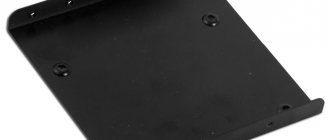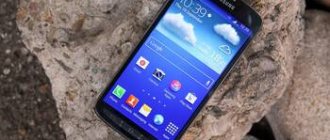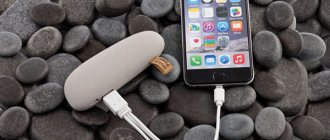Subscribe to our VK community!
For quite some time now, you can find special devices on sale that allow you to charge a mobile phone without an outlet - power banks. They are external batteries with a certain amount of energy. Recently, more powerful products have begun to appear that are designed to work with ultrabooks and laptops.
Additional 15% discount on Mepsi household eco-friendly products until March 26 using promo code OZONHBP235 on products from this page! The promotion may end early.
The latest gadgets are highly valued for the ability to use them without connecting to an electrical outlet. However, not every laptop has a significant battery life that would allow it to work for a long time - it is precisely for such cases that a power bank will be useful. Unfortunately, not every user understands how to approach the selection of such equipment. We decided to help you understand this difficult issue and compiled a rating of the best external batteries for a laptop. In this article we will present the key performance characteristics of the most popular models among users, and also tell you what exactly you should pay attention to when purchasing.
Why does a laptop need a powerbank?
When using a laptop for a long time, the battery is discharged, and, naturally, the moment is approaching when further work will become impossible. In addition, deep discharge of lithium-ion batteries shortens their service life. It is better to charge these batteries more often.
Typically, one hour of laptop operation is enough for the battery to discharge to a third of its capacity. This is already a sign that it is time to connect to the power grid. Many power managers have a setting: what percentage of the full charge is left before the user is warned about the need to recharge. Such functions have also been added to operating systems.
A portable power bank for laptops functions like a power outlet. But not by its appearance - the laptop sees the device not like a person, but by its functions. When connecting the power bank, the power manager reports that the computer is powered from the mains. In fact, this is true, because this device is connected to the laptop with a standard 19 V power connector, just like an AC power supply.
A little more about powering laptops
Laptops use 11V or 14V batteries. Three or four lithium cells with a nominal voltage of 3.6 V produce 10.8 or 14.4 V in series. However, when charging, a higher voltage must be applied to the circuit. Part of the voltage drops through current and voltage stabilization devices, in addition, the power circuit is able to share the current for operation and charging at the same time, unless the battery is too discharged. Hence these 16 or 19 volts, standardized for powering laptops.
Laptops require significant power - after all, they are full-fledged PCs, only in a smaller version. They require several tens of watts to operate, approximately 25-45. If the battery is fully charged, then at a voltage of about twenty volts a current of 1.5 to 2.5 A is obtained. If charging is still required, the current increases from 3 to 5 amperes during operation. When charging without operation, it can be about 1.5A.
It is known that lithium cells take 3-4 hours to charge when completely discharged. More precisely, at a discharge that is calibrated as full, but these are technical details. Thus, it turns out that a laptop requires a device capable of delivering a current of 1.5 A at a voltage of 19 V for at least 3 hours. This means that their ampere-hour capacity must be at least 5 Ah, or 5000 mAh. Of course, the voltage received from this device must not be lower than the nominal one. Technically, it is possible to convert a DC voltage of 3.6 or 5 V into a voltage of 19 or 16 volts, but it is implemented in laptop power banks, and not in the laptops themselves.
There is also news in the power supply of laptops. They are associated with the advent of USB type C. This is a new USB type connector, which has a new specification with great capabilities. Despite the old name of the interface, it can work not only with 5 V, but also with other, higher voltages, up to 20 volts. But so far only the newest devices support this specification.
USB-C is designed in such a way that it can either support a high-speed connection (USB 3.1) or transmit power power of about 100 W, but not at the same time. (When transmitting high current, the cable works like a regular USB 2.0.) The connected devices must comply with the new specification, only in this case they are automatically configured correctly, without damaging the equipment (for example, devices must have a USB PD Rev.1 or Rev.2 profile ).
Canyon CNS-TPBW8
Canyon CNS-TPBW8 cannot be called a “long-liver” - its capacity is modest for devices from this selection of 8000 mAh. However, this is compensated by the low price of the device. In addition, the manufacturer has dressed the gadget in a stylish case with a soft-touch coating and provided support for wireless charging. In addition, the battery weighs only 250 g, which allows you to take it with you on any trip.
Why a regular portable phone battery does not fit laptops
Because it's too weak. It has low capacity and voltage. Although it can supply sufficient current for a short time, it cannot do without increasing the voltage. Even to charge a phone with a 3.3...3.6 V battery, the voltage must be at least 5 V to ensure the desired charging mode. What can we say about a laptop that requires up to 20 volts and a current of several amperes! Even if you create the necessary converter, the battery from a regular smartphone will only partially charge the laptop battery, giving up all its charge.
Some netbooks use 5 V power supply. As a rule, they use an economical processor such as the Intel Atom Z8350. These devices can be charged like a regular smartphone.
RAVPower RP-PB064 Ace
This gadget is both capacious and durable, protected by a fire-resistant case and will surprise users with its enormous “endurance” - it uses a 32,000 mAh energy storage.
Such impressive capabilities influenced the characteristics of the battery - it weighs as much as 550 g. You can put it in your purse, but you won’t be able to carry it with you for a long time. However, if the user needs a reserve of energy, compromises will have to be made. A bonus to the large capacity is the presence of three USB-A ports and a device charge level indicator.
How to choose a power bank for a laptop
What do external batteries for laptops look like and how do they differ from power banks for other devices? First of all, they are larger in size. Not every device is easy to put in your pocket. First, the buyer must find out from the instruction manual or on the website according to the model the properties of his laptop:
- Supply voltage (adapter output).
- Current consumption.
- Capacity of the standard laptop battery.
- Types of connectors for power and charging.
- Protection against polarity reversal and short circuit.
The voltage and current can be found on the sticker on your laptop charger.
Laptops are known to be powered by 19, 16, and (rarely) 12 VDC. The current strength ranges from 1.5...5 A. There are gaming laptops that consume almost twice as much current, since the video card requires significant power for many games. When working with office programs, it is much smaller. So be guided by your style of communication with the computer. If you can't live without gaming, be prepared to buy several powerful power banks and charge them in advance.
Connectors and adapters between devices
Different power sockets are used for a personal computer, so you need to take a closer look at the adapter that came with the laptop itself. You can purchase an adapter, but unless necessary, you should not get carried away with adapters - each such “crutch” increases the likelihood of poor contact. It is better to find a cable with suitable connectors.
If your laptop has a USB-C output, you will need to find out (from the documentation for it or from the device manager in the operating system) whether this port can be used for charging or power. And only after that purchase a certified cable that supports the required current.
Also, for some power banks on the seller’s website or in the instructions there is a list of models in which charging via type C is possible and tested, which is shown below, using the example of Xiaomi power bank 3.
All power banks, especially for laptops, are sold with detailed instructions in paper form, as well as nameplates and inscriptions on the case, which indicate the most important data: output voltage and supplied current. Sometimes this data is not very noticeable, sometimes designers hide it for the sake of beauty.
When using external batteries to power/charge laptops, it is necessary not only to make the connection through the appropriate connectors, but also to select the correct voltage equal to the supply voltage of the laptop. This applies to the DC (circular) type connector. The voltage selection is made either by a manual switch or by a multifunction button that works in conjunction with the indicators.
When purchasing, be guided by different conditions. For example, if you want to not only charge your laptop from a power bank, but also work on it at the same time. This means that the external battery must supply sufficient current, or you will have to wait until the charging LED on your laptop or power bank goes off.
Battery capacity
The most important parameter that should be taken into account along with voltage and current. Battery capacities for laptops range from approximately 2200...13500 mAh, depending on size and power. If the capacity of your laptop battery is equal to the capacity of the power bank, then this makes it possible to fully charge the laptop (or power it) once. That is, the battery life on it doubles.
Try to buy a power bank with a larger capacity, because this is its main function. Even if the device delivers the required current at the required voltage, it will be of little use with a capacity of 2000 mAh. You will only increase the computer's operating time by a dozen or two minutes. This happens because the actual capacity of the cells is limited by the charge controller in the external battery, while the nominal capacity is indicated in the rating data. Remember that a good supply of capacity facilitates the operation of lithium batteries and increases their service life by 2-3 times.
Important! Lithium batteries quickly shorten their service life when deeply discharged. Try to recharge them more often. Don’t get carried away with completely depleting batteries: neither on devices nor in power banks.
Buy capacious power banks, even if you have a low-power computer. These expenses will not go to waste!
The device in the figure has a capacity of about 8000-12000 mAh (depending on the actual capacity of specific batteries). A sensor is glued to one of the elements to monitor the temperature during charging. This control makes it possible to use fast charging. For an average smartphone with a battery capacity of about 2000 mAh, such a power bank will provide 3 or 4 times charging.
Fast charging and other features
Many laptops and smartphones support fast charging (USB Power Delivery). Therefore, it is worth purchasing appropriate power banks that deliver high current. Fast charging is charging with an increased current with the same voltage through a Type C connector. Lithium-ion batteries are not afraid of increased current, but they are very afraid of increased temperature and overcharging with increasing voltage. Therefore, in laptops, when the elements are connected in series for discharge, they are connected exclusively in parallel for charging, according to a circuit of separate DC/DC converters for each element and with temperature control.
In addition to fast charging, an external battery may contain various indications, display, power button, etc.
What computers is the gadget suitable for?
Many batteries are sold with several types of adapters that are designed for different types of devices. Others are tailored specifically for a laptop from one company, for example, such as an external battery for an HP laptop.
Universal portable devices are those that have USB outputs, but most often they are used only for smartphones. Therefore, when purchasing a power bank for a laptop, it is best to check what interfaces it comes with. For example, an Apple laptop is equipped with a specific connector for which you will need a corresponding adapter.
The best power banks for laptops 2019-2020
For convenience and clarity when comparing, data on devices is summarized in a table.
| Model | Capacity, mAh | Exit eg, B | Output current, A | Connectors | A solar panel | Fast charge* | Weight, g | Where can I buy |
| PowerPlant K2 | 50000 | 5, 12, 20 | 1; 2,1; 3 | USBx4, DCx2 | No | Yes | 1200 | Ya.Market |
| RAVPower 26800 | 26800 | 5-20 | 2,4; 2,4; 6 | USBx2, USB-C | No | Yes | 456 | Ya.Market |
| Palmexx Electrobank 23000 | 23000 | 12-20 | 2; 3 | USB, DC | No | Yes | 235 | Ya.Market |
| Rombica Neo Pro180 | 18000 | 5, 12, 16, 19 | 1 and 2 (5 V); 3.2 (12, 16, 19 V) | USBx2, DC | No | Yes | 570 | Ya.Market |
| Rombica Neo Pro280 | 28000 | 5, 12, 16, 19 | 1 and 2 (5 V), 3.2 (12, 16, 19 V) | USBx2, DC | No | Yes | 830 | Ya.Market |
| Digma DG-PD-40000 | 40000 | 5, 12-20 | 3; 8 | USBx2, DC | No | No | 1200 | Ya.Market |
| Cactus CS PBPT18 18000AL | 18000 | 5-20 | 1; 2,1; 3,2 | USBx2, DC | No | No | 570 | Ya.Market |
| Iconbit ftb23000S | 23000 | 5, 12, 16, 19 | 2,1; 3 | USB, DC | Eat | No | 650 | Ya.Market |
| Iconbit ftb20000S | 20000 | 5, 12, 16, 19 | 2; 4 | USB, DC | Eat | No | 980 | Ya.Market |
| Pitatel Notebook Power Station NPS-153 | 41400 | 5, 16, 19 | 4,75 | USB, DC | No | Yes | 1345 | Ya.Market |
* – the fast charge function is taken into account only for the external battery itself
Additional functions
In addition to the basic ones, different power banks may also have a number of additional functions that expand the scope of applicability of the device. Some manufacturers, for example, build a solar panel into the bank body that can charge the battery from sunlight. However, you should not delude yourself on this score, since such charging can only replenish a small part of the energy and, moreover, requires quite a lot of time.
Additional features also include a built-in flashlight, which is really useful. But a fancy LED display with battery characteristics and other functions is needed mostly for beauty.
The most useful additional function is fast charging, which allows you to charge both the battery of the power bank itself and the devices it charges in a minimum period of time.











